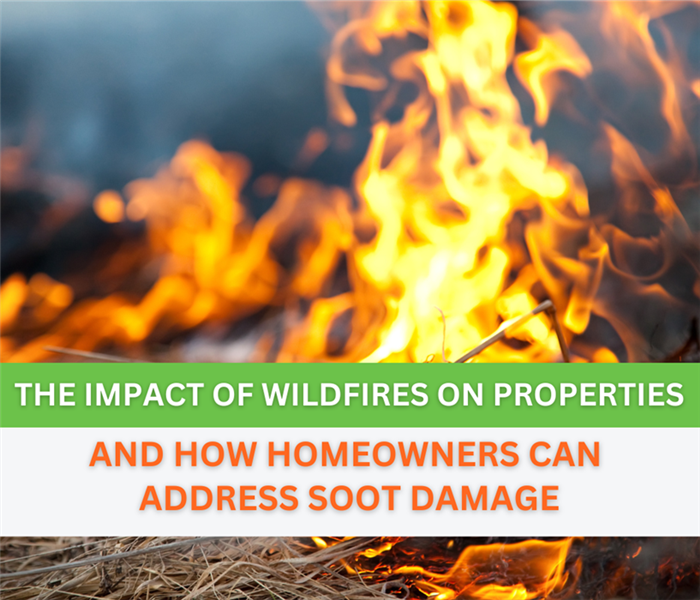The Impact of Wildfires on Properties and How Homeowners Can Address Soot Damage
6/20/2024 (Permalink)
Wildfires can cause widespread devastation, affecting entire communities and leaving behind significant damage to properties. Even if your home survives the flames, the aftermath of a wildfire can still pose serious risks. One of the most common issues homeowners face after a wildfire is soot damage. Here, we explore the effects of wildfires on properties and provide actionable steps for homeowners dealing with soot damage.
The Effects of Wildfires on Properties
- Structural Damage: While direct fire damage is the most obvious threat, the heat generated by wildfires can weaken structural components of buildings, making them unsafe.
- Smoke Damage: Smoke can infiltrate homes, leaving behind a persistent odor and potentially harmful residues on walls, ceilings, and furnishings.
- Soot Damage: Soot is composed of tiny carbon particles that can settle on surfaces throughout a home, causing discoloration, corrosion, and health hazards.
- Water Damage: Efforts to extinguish wildfires often involve large amounts of water, which can lead to water damage in homes, further complicating the cleanup process.
- Air Quality Issues: The fine particles in smoke and soot can degrade indoor air quality, posing respiratory risks, particularly to vulnerable populations like children, the elderly, and those with preexisting health conditions.
Actions Homeowners Need to Take for Soot Damage
If you suspect your home has suffered soot damage after a wildfire, it’s crucial to act promptly to mitigate further damage and health risks. Here are the steps to take:
Ensure Safety First: Before re-entering your home, ensure it has been declared safe by local authorities. Wear protective gear such as masks, gloves, and goggles to avoid inhaling or coming into contact with hazardous particles.
Assess the Damage: Perform a thorough inspection to identify areas affected by soot. Look for discoloration on walls, ceilings, and furniture, and check for a lingering smoke odor.
Contact Your Insurance Company: Notify your insurance company about the damage as soon as possible. Document the damage with photos and detailed notes to support your claim.
Ventilate Your Home: Improve air circulation by opening windows and using fans to help clear out lingering smoke and soot particles. Air purifiers with HEPA filters can also help improve indoor air quality.
Avoid DIY Cleaning: Soot cleanup requires specialized knowledge and equipment. Attempting to clean it yourself can spread particles and potentially cause more harm. Instead, contact a professional restoration company experienced in soot and smoke damage.
Professional Cleaning and Restoration:
- SERVPRO® Soot Removal: Professionals at SERVPRO use industrial-grade vacuums and specialized cleaning agents to remove soot from surfaces. They have the expertise to clean various materials without causing further damage.
- SERVPRO Odor Removal: SERVPRO uses techniques like thermal fogging, ozone treatment, and hydroxyl generators to eliminate smoke odors from your home.
- SERVPRO Air Duct Cleaning: Soot and smoke particles can accumulate in your HVAC system. SERVPRO's professional cleaning ensures that your air ducts are free of contaminants, preventing them from being recirculated throughout your home.
Evaluate and Replace Damaged Items: Some items, especially porous materials like upholstered furniture, carpets, and clothing, may need to be replaced if they are heavily contaminated with soot and smoke. SERVPRO can assist with the evaluation and cleaning or replacement of these items.
Implement Preventative Measures:
- Fire-Resistant Landscaping: Create defensible space around your property by using fire-resistant plants and materials.
- Home Hardening: Upgrade your home with fire-resistant building materials, such as metal roofing and fire-resistant siding, to reduce future wildfire risks.
- Emergency Preparedness: Develop and practice a wildfire evacuation plan. Keep an emergency supply kit on hand and stay informed about local wildfire risks and warnings.
Conclusion
Wildfires are a formidable natural disaster, but understanding the potential impacts on your property and knowing how to address soot damage can help you recover more effectively. Acting swiftly and enlisting professional help, such as that provided by SERVPRO of Alhambra, are crucial steps in restoring your home to its pre-fire condition while ensuring the safety and well-being of your family. Stay informed, prepared, and proactive to protect your home from the ongoing threat of wildfires.





 24/7 Emergency Service
24/7 Emergency Service
